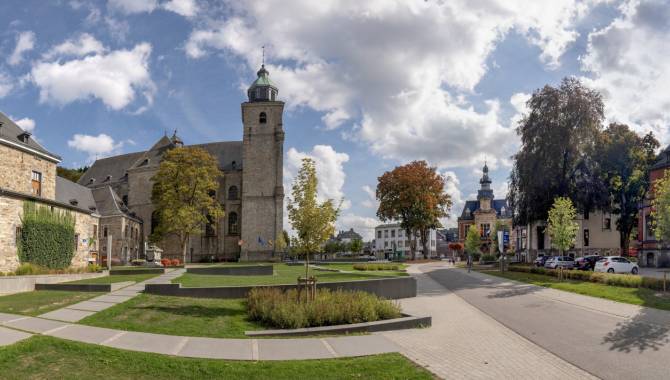Cathedral of St. Peter, St. Paul and St. Quirinus
1/8



Photo: malmedy place du chatelet 360 01 c christian charlier ostbelgien.eu , CC BY ,East Belgium Tourist Agency NPO

Photo: malmedy kathedrale 04 c guy massin , CC BY ,East Belgium Tourist Agency NPO

Photo: malmedy kathedrale 18 c christian charlier ostbelgien.eu , CC BY ,East Belgium Tourist Agency NPO

Photo: malmedy place du chatelet 360 01 c christian charlier ostbelgien.eu , CC BY ,East Belgium Tourist Agency NPO

Photo: malmedy place du chatelet 07 c christian charlier ostbelgien.eu , CC BY ,East Belgium Tourist Agency NPO

Photo: malmedy kathedral 03 c ostbelgien.eu dominik ketz , CC BY ,East Belgium Tourist Agency NPO

Photo: malmedy kathedral 02 c ostbelgien.eu dominik ketz , CC BY ,East Belgium Tourist Agency NPO

Photo: malmedy kathedral 06 c ostbelgien.eu dominik ketz , CC BY ,East Belgium Tourist Agency NPO








Description
The original abbey was built around the end of the 10th century. The heavily symbolic edifice was destroyed in 1689 by the troops of Ludwig XIV. After the French Revolution, the place of worship, rebuilt as from 1776 to plans made by the Liège architect Antoine Galhausen, was used first as a parish church and then as a workshop for joiners and cabinet-makers, before being sold in 1818 to the town of Malmedy and being given the status of a cathedral in the 1920s. The cathedral fascinates people with its simple, straight-lined outward appearance and its plain yet high-quality décor.
Interior simplicity
The simplicity of the exterior can also be seen in the interior. The interior of the church, bathed in light, was influenced not least by the Liège stucco artist François-Joseph Duckers, who was responsible for the greater part of the décor, for example such as the ornamentation of the cupola and the depiction of the Assumption at the front of the choir.
Windows
The glass windows of the cathedral date from 1951. The windows of the choir section represent the six saints Peter, Paul, Quirinus, Remaklus, Gereon and Helena in the form of medallions.
Organ
The organ is regarded as the showpiece of the cathedral. It was built from 1780 to 1783 by the Liège organ builder Mathieu Graindorge and later restored on several occasions.
Timber pulpit
Timber pulpit in the style of Louis XIV dating from 1779.
High altar
High altar in marble dating from 1877.
Silver reliquary busts
Silver reliquary busts of St. Gereon and his companions.
Holy shrine
The wooden chest with the reliquary of St. Quirinus dating from 1698.
Altar of the Virgin Mary
Marble altar of the Holy Virgin dating from 1773.
Confessionals
These four confessionals from the cathedral date from 1770.
Carte
Cathedral of St. Peter, St. Paul and St. Quirinus
Place du Châtelet
4960 Malmedy